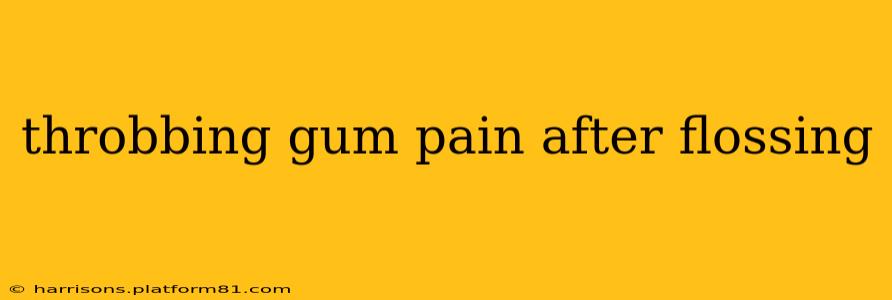Flossing is crucial for maintaining good oral hygiene, but sometimes, this essential practice can leave you with a throbbing gum pain. This isn't necessarily a sign you're doing something wrong; it can stem from several factors. Understanding the causes, finding effective remedies, and implementing preventative measures can help you keep your smile healthy and pain-free.
Why Does My Gum Throb After Flossing?
The throbbing pain you experience after flossing is often a sign of gum irritation or inflammation. Several factors can contribute to this:
- Aggressive Flossing: The most common cause is using too much force while flossing. Gently guiding the floss between your teeth is key; aggressive flossing can injure your gums, leading to bleeding and subsequent throbbing.
- Improper Flossing Technique: Incorrect flossing technique, such as snapping the floss against your gums instead of gently curving it around each tooth, can also cause irritation and pain.
- Gingivitis: Inflammation of the gums (gingivitis) is a common early sign of gum disease. If you already have gingivitis, flossing might initially increase discomfort as it disturbs the inflamed tissues. However, consistent gentle flossing is actually beneficial in treating gingivitis.
- Underlying Gum Disease (Periodontitis): More advanced gum disease, periodontitis, can cause significant gum inflammation and bleeding, potentially resulting in throbbing pain after flossing.
- Recent Dental Work: If you've recently had dental work, such as a cleaning, filling, or extraction, some tenderness and throbbing are normal for a short period. However, persistent or severe pain warrants contacting your dentist.
- Food Impaction: Sometimes, a piece of food can become lodged under the gum line, causing irritation and throbbing pain when disturbed by flossing.
- Dry Mouth: Dry mouth can increase the likelihood of gum irritation and inflammation.
What Can I Do to Relieve the Throbbing?
If you're experiencing throbbing gum pain after flossing, here are some things you can try:
- Rinse with Salt Water: A warm saltwater rinse can help soothe irritated gums and reduce inflammation. Mix ½ to ¾ teaspoon of salt in 8 ounces of warm water and rinse thoroughly.
- Apply Cold Compress: Applying a cold compress to your cheek, over the affected area, can help reduce swelling and numb the pain.
- Over-the-Counter Pain Relief: Ibuprofen or acetaminophen can help manage the pain. Follow the dosage instructions on the packaging.
- Gentle Massage: Gently massage your gums with your finger to improve blood flow and reduce inflammation.
How Can I Prevent Throbbing Gum Pain in the Future?
Preventing throbbing gum pain involves adopting proper flossing techniques and maintaining good oral hygiene:
- Use the Correct Flossing Technique: Use a gentle "C" shape around each tooth, ensuring you reach below the gum line. Avoid snapping the floss against your gums.
- Use the Right Floss: Experiment with different types of floss (waxed, unwaxed, tape floss) to find one that's comfortable for you.
- Floss Regularly: Floss at least once a day, preferably before brushing.
- Maintain Good Oral Hygiene: Brush your teeth twice daily with fluoride toothpaste, and use mouthwash as directed.
- Regular Dental Checkups: Schedule regular dental checkups and cleanings to catch and address any gum problems early.
Is Throbbing Gum Pain After Flossing Always a Cause for Concern?
While mild throbbing after flossing is sometimes normal, especially if you're not used to flossing regularly, persistent or severe pain is a cause for concern. If your pain is accompanied by other symptoms like fever, swelling, pus, or persistent bleeding, seek professional dental care immediately.
When Should I See a Dentist?
You should contact your dentist if:
- The pain is severe or persistent.
- You experience excessive bleeding.
- You notice swelling or pus around your gums.
- You have a fever.
- The pain is accompanied by other symptoms.
By following these tips and seeking professional advice when needed, you can ensure that flossing remains a beneficial part of your oral hygiene routine without causing unnecessary pain. Remember, consistent and gentle flossing is vital for maintaining healthy gums and preventing gum disease.
